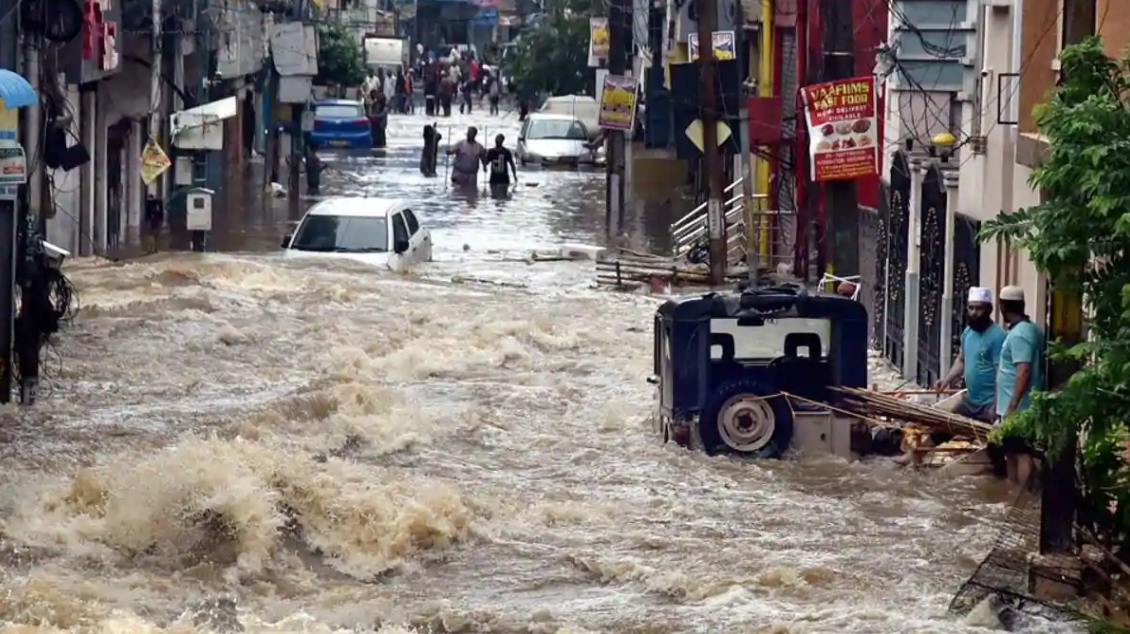
‘Brand Hyderabad’ goes under water as rains wreak havoc
The image of Hyderabad as an international IT hub has taken a severe beating with torrential rains exposing the city’s vulnerabilities and its poor drainage system.

The image of Hyderabad as an international IT hub has taken a severe beating with torrential rains exposing the city’s vulnerabilities and its poor drainage system. As life remains paralysed with waterlogged roads, inundated colonies, and power outages, the much-touted global city is living through a virtual civic nightmare.
Dozens of colonies remained under water and national highways to Vijayawada and Bengaluru remained cut off as incessant rains wreaked havoc, throwing normal life out of gear and prompting the Telangana government to declare a two-day holiday.
“In about 35 places in the city, more than 21 cm rainfall has been recorded in a span of 24 hours till Tuesday night. This is an all-time record,” the meteorologist B Raja Rao said.
The Hussain Sagar lake in the middle of the city crossed the full tank level on Tuesday evening and started overflowing on to the city roads. Several low-lying areas were completely submerged.
The police teams and personnel of Disaster Response Force of the Greater Hyderabad Municipal Corporation (GHMC) and National Disaster Relief Force (NDRF) have evacuated several families from different flooded localities, even as rescue efforts are on in many other areas.
Related news: 2-month-old baby, 10 others killed in Telangana due to heavy rains
Poor planning
The experts have warned that unbridled constructions on the lake beds that block the natural flow of rain water, haphazard urban planning, and poor storm water drainage system have been responsible for flooding. Illegal constructions and massive piles of garbage are choking the city’s drainage system.
“Because of unplanned growth, especially in low-lying areas and areas below the old tanks of the city, the water overflowed and flooded entire colonies. Occupation of storm water drains is the other reason for the flooding,” said Padmanabha Reddy, secretary of the Forum for Good Governance, a city-based NGO.
“We have created barriers to the flow of water across the city and heavy rainfall will obviously have an impact. We need a city-based flood plan because now we know where the water is logging and how it is flowing. We need to fix this and that firstly involves fixing existing storm water drains,” said Prof Purushotham Reddy, environmental activist.
The experts point out that one of the biggest failures of the city planners has been in the area of waste management. “With all the industrial waste and sewage being dumped into the lakes, the holding capacity of the lakes has been severely affected. Add to this the mushrooming of encroachments, you have a recipe for disaster,” Reddy said.
A 2016 report of the Centre for Science and Environment (CSE) had estimated that Hyderabad had lost 3,245 hectares of its wetlands. Rapid urbanisation has significantly altered the natural water course and watersheds.
Related news: IMD warns of heavy rains in coastal Karnataka, other areas in south India
Lessons not learnt
The city had witnessed a nightmare on August 24, 2000, when an intense rainfall of 240 mm in a span of 24 hours played havoc. An expert committee, constituted by the then Telugu Desam Party government, faulted encroachments on nalas (drainage channels) for the intensity of the flooding.
The Kirloskar Consultants Committee identified thousands of illegal encroachments that were blocking the natural flow of rain water and found that the city’s drainage system was designed to handle 12 mm rain per hour.
The storm water drains, constructed during the Nizam’s era, were meant for a population of five lakh and a municipal area of 54 sq. km but the city population has now crossed one crore and the area covers 625 sq. km. Most new settlements and colonies outside the core area of Hyderabad and on the peripheries are examples of unplanned urban growth and unregulated planning.
“If the Kirloskar Committee’s report is to be implemented, about 28,800 properties will have to be razed, spending about Rs 12,000 crore as compensation. This is impractical and involves displacement of several slum dwellers,” an official of the municipal department said.
Related news: IMD forecasts rains across Maharashtra for next 5 days
Instead, the GHMC has identified 346 road vulnerable points which are prone to water stagnation and earmarked Rs 230 crore for tackling bottlenecks for 47 storm water drains. The GHMC also took up improvement of bottlenecks on 47 storm water drain at a cost of Rs 230 crore as a long-term measure to prevent water-logging in some areas of the city. The government had shut down 13 chemical industries which were releasing hazardous effluents directly into nalas.
“The GHMC has 1,221 km of storm water drain which is insufficient and causing water stagnation at various localities during rainy season. Apart from this, lakes and nalas are encroached upon resulting in a reduction of the capacity of the lakes and nalas,” the State Municipal Administration Minister K T Rama Rao said.
Hyderabad has an aged drainage and sewerage system, with only 1,500 km of drain main canals and 2 lakh manholes, as against a requirement of 5,500 km of drain canals and 4.20 lakh manholes. Over the past six decades, nothing much has been done towards remodelling the drains.
The civic activists contend that the successive governments have failed to complete the remodelling and widening of storm water drains even 8 to 10 years after it was conceptualised.
Every year, during the monsoon season, parts of the city get flooded because of encroachments on the nalas which decreases the ability of these drainage channels to carry off the extra water. The work of widening nalas and demolishing encroachments has been painfully slow.


